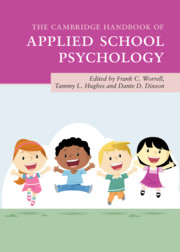Book contents
- The Cambridge Handbook of Applied School Psychology
- The Cambridge Handbook of Applied School Psychology
- Copyright page
- Contents
- Contributors
- Contributor Biographies
- Acknowledgments
- 1 Broadening the Focus of School Psychology Practice
- Part I Individual-Level Academic Interventions
- Part II Teacher- and System-Level Interventions
- Part III Interventions from Educational and Social/Personality Psychology
- Part IV Behavioral and Social-Emotional Interventions
- 19 Internalizing Problems and Disorders of Childhood
- 20 Adolescent Suicidal Behavior in Schools: What to Know and What to Do
- 21 Emotional Disturbance versus Social Maladjustment
- 22 Autism Spectrum Disorder and Illegal Acts
- 23 Effective Bullying Prevention and Intervention Strategies for School Professionals
- 24 Principles of Prevention and Intervention to Close Discipline Gaps in Schools
- 25 Social and Emotional Learning in Schools
- Part V Health and Pediatric Interventions
- Part VI Family Connections and Life Transitions
- Part VII Special Populations
- Part VIII Conclusion
- Index
- References
19 - Internalizing Problems and Disorders of Childhood
from Part IV - Behavioral and Social-Emotional Interventions
Published online by Cambridge University Press: 18 September 2020
- The Cambridge Handbook of Applied School Psychology
- The Cambridge Handbook of Applied School Psychology
- Copyright page
- Contents
- Contributors
- Contributor Biographies
- Acknowledgments
- 1 Broadening the Focus of School Psychology Practice
- Part I Individual-Level Academic Interventions
- Part II Teacher- and System-Level Interventions
- Part III Interventions from Educational and Social/Personality Psychology
- Part IV Behavioral and Social-Emotional Interventions
- 19 Internalizing Problems and Disorders of Childhood
- 20 Adolescent Suicidal Behavior in Schools: What to Know and What to Do
- 21 Emotional Disturbance versus Social Maladjustment
- 22 Autism Spectrum Disorder and Illegal Acts
- 23 Effective Bullying Prevention and Intervention Strategies for School Professionals
- 24 Principles of Prevention and Intervention to Close Discipline Gaps in Schools
- 25 Social and Emotional Learning in Schools
- Part V Health and Pediatric Interventions
- Part VI Family Connections and Life Transitions
- Part VII Special Populations
- Part VIII Conclusion
- Index
- References
Summary
The constructs now subsumed under the label “internalizing disorders” had garnered the attention of researchers and practitioners long before the recent terminology was coined in the 1980s. Spanning decades of research, intervention, and practice, this chapter describes childhood internalizing disorders by their traits and prevalence, and then highlights the important contribution of factor analysis in marking their scientific evolution. We learn how exposure of the underlying dimensionality of internalizing disorders, along with critical refinements to terminology, precipitated the identification of early (subsyndromal) symptoms of depression and anxiety, and paved the way for the development of assessment scales that would ultimately expand our ability to intervene with precision, refine research, develop methods for prevention, identify moderator variables, and discover the potential of universal screening. The chapter concludes by providing a brief sampler of tools currently in use by practitioners and schools for the treatment, reduction of symptoms, and prevention of internalizing disorders.
- Type
- Chapter
- Information
- The Cambridge Handbook of Applied School Psychology , pp. 317 - 334Publisher: Cambridge University PressPrint publication year: 2020



